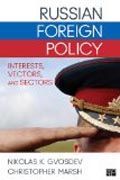
In a truly contemporary analysis of Moscow's relations with its neighbours and other strategic international actors, Gvosdev and Marsh use a comprehensive vectors approach, dividing the world into eight geographic zones. Each vector chapter looks at the dynamics of key bilateral relationships while highlighting major topical issues—oil and energy, defence policy, economic policy, the role of international institutions, and the impact of major interest groups or influencers—demonstrating that Russia formulates multiple, sometimes contrasting, foreign policies. Providing rich historical context as well as exposure to the scholarly literature, the authors offer an incisive look at how and why Russia partners with some states while it counter-balances others. INDICE: List of Tables, Figures, and MapPrincipal Vectors in Russian Foreign PolicyPrefaceAcknowledgmentsAbout the EditorsIntroduction The Challenges Facing Russia1. The Historical Legacy for Contemporary Russian Foreign Policy The Soviet Legacy2. Vectors and Sectors: The Russian Foreign Policy Mechanism The Constitutional Structure: President and Prime Minister Searching for a Role: The Legislature The Position of the Foreign Ministry: One Actor Among Many The Regional Governments The State Companies and Private Business The Nongovernmental Organizations Russian National Security Decision Making The Principal Vectors3. The United States: The Main Enemy or Strategic Partner? Legacy of the Cold War Gorbachev: The Search for Condominium The Yeltsin Era and Tainted Transactions Putin-Bush and Obama-Medvedev: Soul Connections? Some Enduring Obstacles Institutionalizing the Relationship The Balance Sheet4. The Bear and the Dragon: China and the East Asia Vector Triangular Relations: Opportunities and Challenges The Dragon Turns to the Bear The Bear Embraces the Dragon The Bear Arms the Dragon An Emerging Strategic Alliance? Mending Fences: Russia-Japan Relations Korea: Unparalleled Relations Vietnam: Moscow's Toehold in Southeast Asia Setting Its Eyes on Asia5. The Eurasian Space The Disintegration of the Soviet Union The Eurasian Vision Breaking Up Is Hard To Do The Frozen Conflicts The Georgia-Russia War and Its Aftermath The Ties That Bind Securing Eurasia A Eurasian Convergence Zone? The Eurasian Union: USSR Lite? Euraskepticism Putin’s Eurasian Dream6. Eastern Europe: Comrades no More The Second World War and the Creation of the Soviet Bloc 1989-1999: The Attempt to Preserve Eastern Europe The Baltics and Beyond: NATO’s Reach East Baltic [In]Security From Tragedy to Reconciliation? Developments in Russia-Poland Relations Russian Impotence in the Balkans Moscow’s Ruble Diplomacy and Russia's Return to Eastern Europe7. Europe: Russia's Traditional Orientation Russia and the European Union Since the Soviet Collapse The Russo-German Relationship The Russian Relationship with France The Overlooked Partnership: Italy and Russia The Bulldog and the Bear: Russia and Great Britain Other Relationships The Arctic Dimension Concluding Thoughts8. The Near-Eastern Vector Russia-Turkey: The Unexpected Partnership Israel: Practically a Russian-Speaking Country? Russia-Saudi Arabia: The Start of a Rapprochement? Traditional Arab Partners Moscow’s Traditional Ally Syria The Transformation of Russian-Iranian Relations Overall Conclusion9. Call Across the Himalayas: The South Asia Vector The Immediate Post-Soviet Policy The Failed Rapprochement with Pakistan? The Model Partnership: India The Russia-India-China Troika Drivers of the Indo-Russian Entente10. Africa and Latin America: The Southern Vector The Return to Africa Latin America Beckons Building the BRICS11. EpilogueIndex
- ISBN: 978-1-4522-3484-7
- Editorial: CQ Press
- Encuadernacion: Rústica
- Páginas: 456
- Fecha Publicación: 29/10/2013
- Nº Volúmenes: 1
- Idioma:
